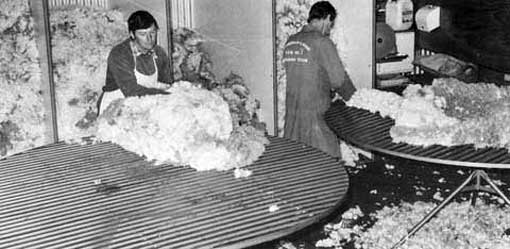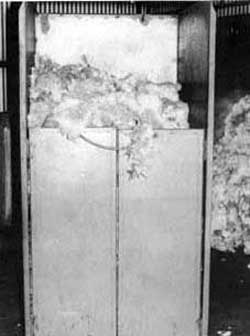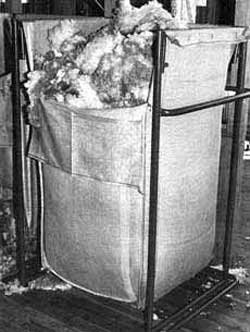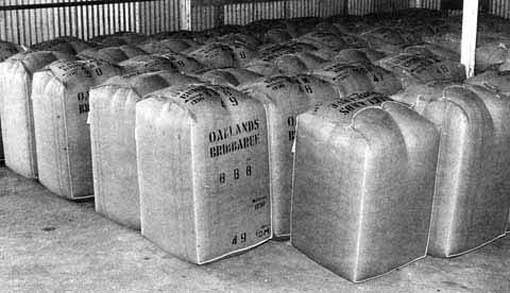
Shearing shed design - the wool room
Wool room design
A well planned and designed wool room allows wool to be moved smoothly through skirting, classing, baling and storage.
The aim is to eliminate unnecessary operations (such as excessive walking and wool rehandling) and to modify others so maximum attention can be given to the important task of preparing the clip for sale.
The working environment also influences the efficiency of clip preparation. It should be designed with enough floor space to allow shedworkers unrestricted movement around wool tables, wool bins and the wool press. There should also be enough room for storage of bales.
| Number of shearing stands | |||||
|---|---|---|---|---|---|
| 2 | 3 | 4 | 5 | 6–8 | |
| Suggested minimum area (m2) | 50 | 60 | 80 | 85 | 95 |
Floor
Choice of floor type depends on whether the wool room is located above ground or at ground level.
Above ground
Sheep can be stored underneath this type of floor. Floors of 19 mm thick tongue-and-groove pine wood are satisfactory when joist spacings are 450 mm and the wood is of good quality. Closer joist spacings (380 mm instead of 450 mm) and hardwood floor boards may be required for the floor beneath heavy wool presses.
To prevent grease build-up on the floor, to make sweeping easier and to preserve appearance, a tung-oil can be used on new floors, or a decking finish on older floors.
Ground level
Raised-board shearing sheds with wool rooms constructed from reinforced concrete floors are becoming more common. When not in use for shearing or crutching, the wool room can be used for storing vehicles, equipment or grain. These practices have to be reviewed when shed tidy and quality assurance schemes are employed. Large access doors are an advantage when using the wool room for other purposes. A smooth floor surface is important for ease of cleaning.
Equipment
Wool tables
Rectangular tables, about 2750 mm long, 1500 mm wide and 850 mm high, have traditionally been used for skirting and classing wool. The table top has wooden slats or tubular steel rollers, spaced with 50 mm to 75 mm gaps large enough for locks and second cuts to fall through. Two shed workers, one on each side, are required for efficient operation of a rectangular table.
Round, rotating wool tables are used because they make efficient use of labour. The circular table can be operated by one person, the top rotating on a central pivot as the fleece is skirted. They are commonly used as a back-up to a rectangular table.
Round wool tables vary from 2030 mm to 2250 mm in diameter. Tubular steel or PVC tubing is normally used for the table top. Slat spacings are similar to those on rectangular tables.
Throwing a fleece onto a round table requires a modification of the technique used for a rectangular table. The fleece should be thrown at a higher angle and less vigorously than for a rectangular table.

More than one table should be used in shearing sheds with three or more stands. This nearly always leaves a clear table for the next shorn fleece, avoiding double handling.
Wool tables should be close to the shearers to reduce walking distance for the shed workers. Automated quick action presses can be close to the wool table (almost between two tables), so the fleeces of the main line can be put straight into the press, further reducing walking distance and the need for rehandling fleeces.
Wool storage bins
Wool bins used to store fleeces and oddments awaiting pressing are typically 1200 mm wide, 2400 mm deep and 1850 mm high. These hold about 400 kg of fleece wool. Wool bins have normally been permanent fixtures in the wool room, but movable or folding bins allow greater versatility. For example, individual wool bins along a wall can be made to swing back against the shed wall after shearing, allowing the wool room to be used for other activities.
 |  |
Mobile bins are ideal for pieces, bellies or locks. Plan their location to give the shed worker immediate access, and to allow the bin to be easily moved to the press when full. Also, where the main fleece line is going straight into the press, mobile bins are useful for holding fleeces when the press is being used for other wool lines.
Self-supporting wool pack frames (see Figure 3) may be used instead of the mobile bin. Pack frames are sometimes mounted on wheels to improve mobility.
Woolbrokers generally provide cardboard cartons for storing skin pieces and stains.
Locks box
Locks accumulating on the shearing board and under the wool table can be collected quickly in a locks box. This is an open box which has its top set flush with the wool room floor. A wool pack is fitted inside and the locks are swept directly into it without further handling. A mesh cover or guard rail frame holds the pack in position and prevents accidents.
The bottom of the locks box should be of mesh to allow any rubbish to fall through and to reduce suction resistance as filled butts are lifted out.
The sides of the locks box have a slight taper and are constructed from a smooth timber or particle board so that the butt can be easily lifted out by two people standing on opposite sides of the box. A lightly tramped butt retains its shape well. The wool from two butts is generally enough to make a good bale.
Wool press
There is a wide range of wool presses available and a careful choice can streamline wool handling. Manual presses are best used only with small flocks. They are slow, labour-intensive and increase double handling of wool. Electrically powered wool presses, although more expensive to buy, are extensively used because they allow savings in labour and they press bales closer to the maximum allowable weight. If electric power is not available, presses powered by a stationary petrol engine are available.
A power-operated wool press enables heavy bales to be pressed, allowing up to 30 per cent reduction in the number of bales leaving the shed. This reduces the number of woolpacks used, freight costs, brokers’ fees and wool sampling charges. It may also free the woolpresser for other shed work such as penning up.
Automatic self-pinning wool presses with a built-in weighing scale are also desirable. Scales which give continuous indication of the weight of wool in the bale reduce the chance of pressing lightweight or overweight bales.
Checklist for buying a new wool press
- The press should be mobile and fitted with wheels of about 150 mm diameter. The wheels should have a large face width to help distribute the press weight on the shed floor.
- If the press is to be moved from shed to shed, ensure that:
- its overall dimensions allow it to pass through doorways;
- there is a minimum of dismantling prior to transport;
- the maximum working height is satisfactory for all sheds involved;
- it will fit into a utility vehicle if required.
- Since the press is on wheels, the total weight of the press plus a bale of wool is carried on the small area where the wheels contact the floor. This requires a strong, solid floor.
- The thrust of the press should be at least 10 tonnes. The thrust is the maximum force which can be applied to the wool to compress it. Although related to one of the fundamental features of a wool press, few manufacturers quote this information in their literature.
- Cycle time for the platen to move from the ‘up’ position to fully down and automatically return should not exceed 25 seconds when the press is empty. This time value is a useful guide to speed of operation.
- Controls should be simple, accessible and clearly indicated. Once started, the platen cycle should be automatic but with manual override.
- Power and voltage requirements for electric motors should be within the range available at the shearing shed. In general, power need not exceed 2.4 kW (3 hp) and voltage should be 240 V, 480 V, or both.
- The press should have an automatic self-pinning facility.
- A continuous indicator is required to show the weight of wool in the press. Accuracy to 10 kg is adequate, with clear markings on a scale or numbers on a readout which can be easily seen when operating the press.
- It should be reasonably easy to fit a new pack into the press.
- Fastening a bale should be simple and involve a minimum of interference from surrounding parts of the press.
- Removal of the completed bale from the press should be quick and require a minimum of effort. A hand trolley should be used to take the bale from the press box, rather than tip the bale on the floor first.
- It is an advantage to be able to load wool from one side of the press and remove the completed bale from the opposite side.
- Noise level in operation should be acceptable.
- Service facilities should be readily available.
Bale storage and loading
The storing and transporting of pressed bales needs careful consideration. It is essential that bales can be moved easily from the press to a storage area and later loaded onto transport. A well-designed hand trolley makes it easy to move bales weighing up to 200 kg. It also allows bales to be stacked in an upright position anywhere in the wool room.
Floor space permitting, bales should be stored on their ends to avoid the need for lifting and double handling. As a guide 35 m2 is sufficient area to store 50 bales of wool in an upright position. A large bale storage area, built into the wool room, may add to the overall cost of a shearing shed. An alternative storage area may be a skillion added to the shearing shed, used as a truck parking and loading bay as well. A loading platform should be 3 m wide, 1.5 m out from the shed and at least truck tray height.

Further information
For further information on shearing shed design, see the following publications:
- Shearing shed design—sheep storage and movement (Agfact A3.E.1)
- Shearing shed design—the board (Agfact A3.E.2)
- Shearing shed design—lighting and ventilation (Agfact A3.E.4)
Acknowledgment
This Agfact was adapted in part from the Australian Wool Corporation publication Wool Harvesting Notes.

